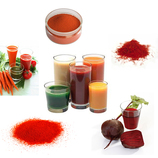Natural Food Coloring

Natural food coloring is enjoying a renaissance due to consumer demand for natural additives in food and beverages. We will introduce you to natural colors derived from agricultural and biological sources. The very first method of providing additional coloring to food was achieved by adding a natural additive of a specific hue. Technological advances nearly a century and a half ago allowed for synthetic colors to be manufactured on a large scale, greatly reducing demand for naturally derived alternative.
Current health trends have shifted ingredient awareness to new levels and as a result, the contents in food and beverages are becoming more relevant in purchasing decisions. All-natural products continue to gain popularity and have become a critical marketing tool across a wide variety of companies in modern food and beverage industries.
Taste perception is powerfully influenced by the color of a food or beverage. Specific colors influence the perceived flavor profile even when opposing flavors are present. The following ABC special offers fascinating insight as to the effect of color and taste.
Current health trends have shifted ingredient awareness to new levels and as a result, the contents in food and beverages are becoming more relevant in purchasing decisions. All-natural products continue to gain popularity and have become a critical marketing tool across a wide variety of companies in modern food and beverage industries.
Taste perception is powerfully influenced by the color of a food or beverage. Specific colors influence the perceived flavor profile even when opposing flavors are present. The following ABC special offers fascinating insight as to the effect of color and taste.
|
Natural food coloring plays an important role in the balance between consumers expecting both a natural and visually attractive food or beverage item.
Natural food coloring is a commonly known household and industry subcategory of food coloring but is not defined by regulation. Due to complex regulatory issues and definitions relating to source materials and the various methods of isolating a given coloring ingredient, the entire category is defined as color additives exempt from certification. The major suppliers have each identified what they consider to be natural food coloring, specifically coloring derived from agricultural, mineral, or biological sources that have a simple extraction process and long history of safe usage. |
|
|
|
Intuitive navigation offers comprehensive information regarding natural food coloring by color, type, source and availability. Technical data is provided where applicable as well as regulatory and labeling guidance. External links will provide additional specific and relevant reference information, such as this recent FDA panel meeting.
The coffee giant Starbucks was recently in the news because although they were in fact using a 'naturally derived' source to color a smoothie product, the source happened to be an insect. Read more about this in our new blog and learn how to identify this in other food products on the store shelf. |
Organic
The popularity of organic food has led to the resurgence of all types of different recipes that include the designation as a suggestion to the pesticide-based alternative. This has certainly spilled over into the coloring market. There have not been definitive studies on the effect of organic on the color of food and the degree of chemical compounds which may or may not be present in the color composition. There are specific fruits and vegetables that are known to not necessarily benefit from the effects of organic farming. For those of you interested in do-it-yourself coloring using your own vegetables at home, the choice is simple. If organic products are used as the sole ingredient make up -the end results will be technically organic natural food coloring.